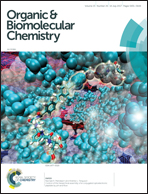Recent progress in the catalytic carbene insertion reactions into the silicon–hydrogen bond
Abstract
The following review will explore the historical development of Si–H bond insertion reactions, giving an up-to-date account on the metal catalysts often employed, in addition to an assessment of their strengths and weaknesses. Diazo compounds have great synthetic potential as versatile reagents for the formation of metal carbenes, allowing the selective formation of C–C and C–heteroatom bonds and thus the introduction of functional groups into organic molecules. C–Si bond-forming methods, that introduce silicon motifs into organic molecules, rely on catalysts derived from metals such as rhodium, copper, iridium, silver, ruthenium, and iron to achieve the desired activities and selectivities.



 Please wait while we load your content...
Please wait while we load your content...